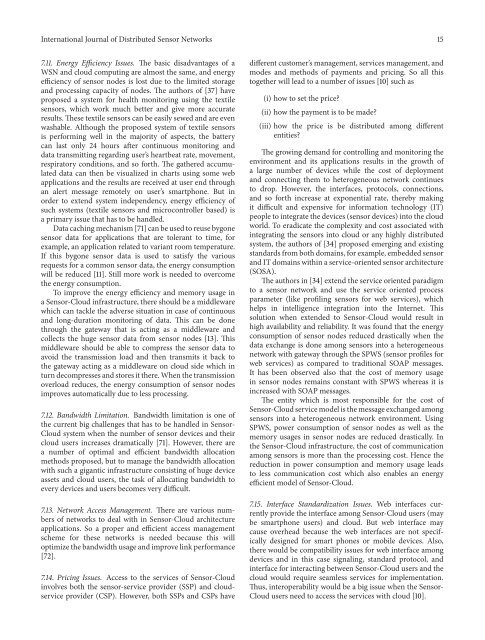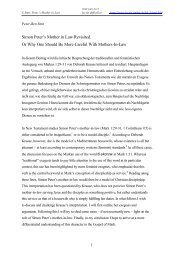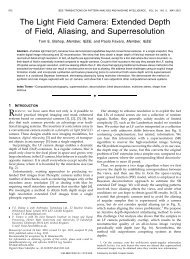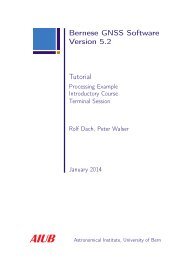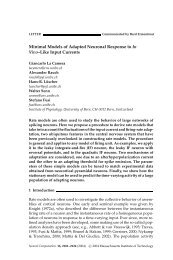Deploying Real-Life WSN Applications: Challenges ... - IAM - CDS
Deploying Real-Life WSN Applications: Challenges ... - IAM - CDS
Deploying Real-Life WSN Applications: Challenges ... - IAM - CDS
Create successful ePaper yourself
Turn your PDF publications into a flip-book with our unique Google optimized e-Paper software.
International Journal of Distributed Sensor Networks 15<br />
7.11. Energy Efficiency Issues. The basic disadvantages of a<br />
<strong>WSN</strong> and cloud computing are almost the same, and energy<br />
efficiency of sensor nodes is lost due to the limited storage<br />
andprocessingcapacityofnodes.Theauthorsof[37] have<br />
proposed a system for health monitoring using the textile<br />
sensors, which work much better and give more accurate<br />
results. These textile sensors can be easily sewed and are even<br />
washable. Although the proposed system of textile sensors<br />
is performing well in the majority of aspects, the battery<br />
can last only 24 hours after continuous monitoring and<br />
data transmitting regarding user’s heartbeat rate, movement,<br />
respiratory conditions, and so forth. The gathered accumulated<br />
data can then be visualized in charts using some web<br />
applications and the results are received at user end through<br />
an alert message remotely on user’s smartphone. But in<br />
order to extend system independency, energy efficiency of<br />
such systems (textile sensors and microcontroller based) is<br />
a primary issue that has to be handled.<br />
Data caching mechanism [71] can be used to reuse bygone<br />
sensor data for applications that are tolerant to time, for<br />
example, an application related to variant room temperature.<br />
If this bygone sensor data is used to satisfy the various<br />
requests for a common sensor data, the energy consumption<br />
will be reduced [11]. Still more work is needed to overcome<br />
the energy consumption.<br />
To improve the energy efficiency and memory usage in<br />
a Sensor-Cloud infrastructure, there should be a middleware<br />
which can tackle the adverse situation in case of continuous<br />
and long-duration monitoring of data. This can be done<br />
throughthegatewaythatisactingasamiddlewareand<br />
collects the huge sensor data from sensor nodes [13]. This<br />
middleware should be able to compress the sensor data to<br />
avoid the transmission load and then transmits it back to<br />
the gateway acting as a middleware on cloud side which in<br />
turn decompresses and stores it there. When the transmission<br />
overload reduces, the energy consumption of sensor nodes<br />
improves automatically due to less processing.<br />
7.12. Bandwidth Limitation. Bandwidth limitation is one of<br />
the current big challenges that has to be handled in Sensor-<br />
Cloud system when the number of sensor devices and their<br />
cloud users increases dramatically [71]. However, there are<br />
a number of optimal and efficient bandwidth allocation<br />
methods proposed, but to manage the bandwidth allocation<br />
with such a gigantic infrastructure consisting of huge device<br />
assets and cloud users, the task of allocating bandwidth to<br />
every devices and users becomes very difficult.<br />
7.13. Network Access Management. There are various numbers<br />
of networks to deal with in Sensor-Cloud architecture<br />
applications. So a proper and efficient access management<br />
scheme for these networks is needed because this will<br />
optimize the bandwidth usage and improve link performance<br />
[72].<br />
7.14. Pricing Issues. Access to the services of Sensor-Cloud<br />
involves both the sensor-service provider (SSP) and cloudservice<br />
provider (CSP). However, both SSPs and CSPs have<br />
different customer’s management, services management, and<br />
modes and methods of payments and pricing. So all this<br />
together will lead to a number of issues [10]suchas<br />
(i) how to set the price?<br />
(ii) how the payment is to be made?<br />
(iii) how the price is be distributed among different<br />
entities?<br />
The growing demand for controlling and monitoring the<br />
environment and its applications results in the growth of<br />
a large number of devices while the cost of deployment<br />
and connecting them to heterogeneous network continues<br />
to drop. However, the interfaces, protocols, connections,<br />
and so forth increase at exponential rate, thereby making<br />
it difficult and expensive for information technology (IT)<br />
people to integrate the devices (sensor devices) into the cloud<br />
world. To eradicate the complexity and cost associated with<br />
integrating the sensors into cloud or any highly distributed<br />
system, the authors of [34] proposed emerging and existing<br />
standards from both domains, for example, embedded sensor<br />
and IT domains within a service-oriented sensor architecture<br />
(SOSA).<br />
The authors in [34] extend the service oriented paradigm<br />
to a sensor network and use the service oriented process<br />
parameter (like profiling sensors for web services), which<br />
helps in intelligence integration into the Internet. This<br />
solution when extended to Sensor-Cloud would result in<br />
high availability and reliability. It was found that the energy<br />
consumption of sensor nodes reduced drastically when the<br />
data exchange is done among sensors into a heterogeneous<br />
networkwithgatewaythroughtheSPWS(sensorprofilesfor<br />
web services) as compared to traditional SOAP messages.<br />
It has been observed also that the cost of memory usage<br />
in sensor nodes remains constant with SPWS whereas it is<br />
increased with SOAP messages.<br />
The entity which is most responsible for the cost of<br />
Sensor-Cloudservicemodelisthemessageexchangedamong<br />
sensors into a heterogeneous network environment. Using<br />
SPWS, power consumption of sensor nodes as well as the<br />
memory usages in sensor nodes are reduced drastically. In<br />
theSensor-Cloudinfrastructure,thecostofcommunication<br />
among sensors is more than the processing cost. Hence the<br />
reduction in power consumption and memory usage leads<br />
to less communication cost which also enables an energy<br />
efficient model of Sensor-Cloud.<br />
7.15. Interface Standardization Issues. Webinterfacescurrently<br />
provide the interface among Sensor-Cloud users (may<br />
be smartphone users) and cloud. But web interface may<br />
cause overhead because the web interfaces are not specifically<br />
designed for smart phones or mobile devices. Also,<br />
there would be compatibility issues for web interface among<br />
devices and in this case signaling, standard protocol, and<br />
interface for interacting between Sensor-Cloud users and the<br />
cloud would require seamless services for implementation.<br />
Thus,interoperabilitywouldbeabigissuewhentheSensor-<br />
Cloud users need to access the services with cloud [10].


